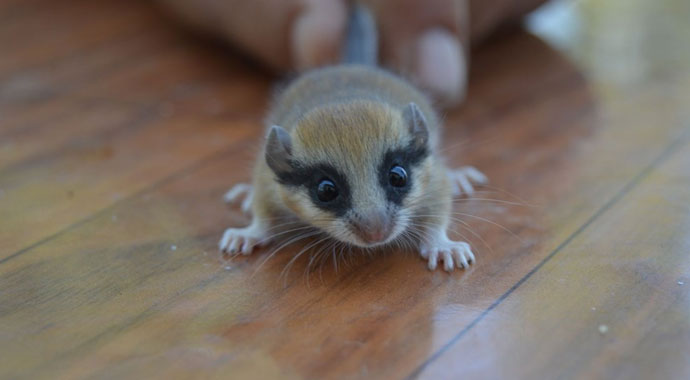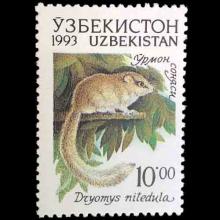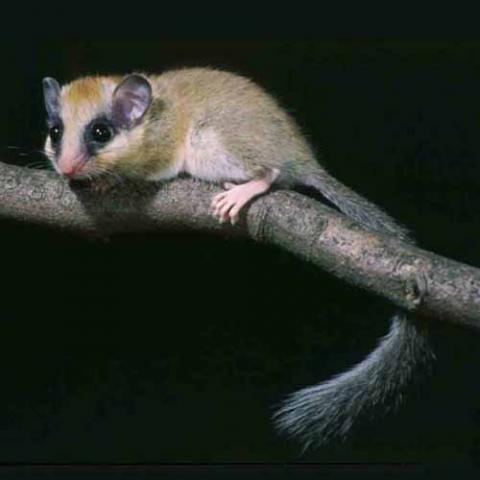NAMES
TAXONOMY
Uzbekistan
Issued:
Stamp:
Dryomys nitedula
Uzbekistan
Issued:
Stamp:
Dryomys nitedula
Uzbekistan
Issued:
Stamp:
Dryomys nitedula
Seen in Afyonkarahisar, endangered
The endangered tree dormouse (dryomys nitedula) was viewed in the Sinanpaşa district of Afyonkarahisar.
The animal (Dryomys nitedula) seen in the vineyard house in Tınaztepe town was first compared to a mouse. The owner of the vineyard house Nizamettin Kapar, who thinks that the animal is not a mouse due to the size of his eyes and the spots under his custody, made a research on the internet. Kapar saw that the animal was the endangered tree dormouse.
Kapar, who later reported the situation to the Nature Conservation and National Parks 5th Regional Directorate, was asked to "leave the animal to nature if there is no injury". Kapar said that while they were having a picnic in the vineyard house in the afternoon, he removed the seven o'clock heads from a safe next to them.
Kapar said that they first realized that the hands and feet of the animal they thought were mice were different.
"A creature that is not too big. Later, we searched the internet with curiosity and learned that it was not a mouse. It was a rare animal. We did not know its name because we did not see such an animal here. Then we learned that the animal is seven sleepers. We will leave the seven sleeper to nature."

"LIVES USUALLY ON TREES"
Afyon Kocatepe University Nature Conservation and Biomonitoring Application and Research Center Director Assoc. Dr. Uğur Cengiz Erişmiş also stated that the endangered dormouse are in the rodents class.
Stating that these animals resemble dormouse in size, Erişmiş used the following expressions: "Seven sleepers 'glis glis', 'dryomys laniger' and 'dryomys nitedula' are species seen in our country. In some regions, they are known as 'Hasancık' and 'forest mouse'. This species, which is under the threat of extinction in our country, also lives in forest areas. This animal is a species that can sleep 7 months of the year. It is also said that it got this name because it usually sleeps in groups of seven during sleep.
Genus species (Animalia): Dryomys nitedula
Its appearance is squirrel-like. On average, the forest dormouse is 110 mm long with a fluffy grey tail nearly as long as its body. The head and body length can range from 80 mm to 130 mm, while the length of the tail can range from 60 mm to 113 mm. The range of its body mass is between 18 grams and 34 grams. The fur on the upper parts of the body is grayish-brown while the underparts are yellowish-white. A black stripe surrounds the eye and extends to the small ear. The whiskers form a bushy tuft about 10mm long. There are six pads on each paw. It has bilateral symmetry and is endothermic.
Distribution and habitat
The range of the forest dormouse is from Switzerland in the west, through central, eastern and southern Europe, the Balkan Peninsula, northward to the Baltic Sea and eastward to the Volga River and the Ural Mountains in Russia. Isolated populations occur outside this range, including in Israel, central Iran, Afghanistan, the Tien Shan mountains and Sinkiang in China. The forest dormouse lives in a wide range of habitats, including broad-leaved, mixed and coniferous woodlands. It is also found in rocky areas, dwarf montane woodland, evergreen shrubland and wood-steppe. It is reported to be found at altitudes up to 3,500 m. This species is most likely to be found in dense forests. Forest dormice tend to create their natal nests on top of lower tree branches or in the midst of thick shrubbery. These nests are usually one to seven meters above ground level. They are spherically shaped with a diameter between 150mm to 250mm. Typically these nests only have one entrance and it faces the tree trunk. The outside of the nest is made from leaves and twigs. The inside of the nest has a lining that is created from bark and moss pieces. Forest dormice tend to pay great attention to detail when they create these natal nests. They want to make sure their young are protected.
Biology
Depending on where this species is geographical located determines whether or not it hibernates and for how long. In Israel, forest dormice stay active throughout the year. However, during the winter they do go through a period of torpor for a certain amount of time each day. Forest dormice located in the north tend to hibernate from October until April. During this period of hibernation, northern dormice will sit on their back legs and curl up into a ball. Its tail will wrap around its body and its hands may touch its cheeks. In all hibernating species, body temperature decreases from the range of 35-37 °C to about 5 °C. Not much is known about the mating rituals of this species. It is known that this species is dependent on maternal care for the first couple of weeks after birth. Female forest dormice have eight mammary glands. Forest dormice breed during various times of the year depending on their geographical location. For example, forest dormice who live in Israel have a breeding season that starts in March and lasts until December. However, in Europe breeding season is much shorter as it starts in March and only lasts until the end of August. There is a correlation between length of the breeding season and number of litters produced per year. For this reason, forest dormice who live in the south who have a longer breeding season usually produce two litters while the dormice who live in the north and have a very short breeding season usually only have time to produce one litter. The gestation period lasts about four weeks, and usually four or five young are born per litter. From time to time, it is possible for the female to give birth to up to seven young at one time. When the young are born, they weigh about 2 grams. The young dormice open their eyes at two weeks, and start eating solid food a week later. During the dependency period, the mother provides food, milk, grooming, and protection to the young. They leave the nest after about another three weeks and become sexually mature in the following year. There has not been much evidence for paternal care. However, it should not be ruled out. The average lifespan of forest dormice in the wild is five and a half years. The gender ratio is about 1:1, with insignificant predominance of females.
Ecology
When it comes out of hibernation in the spring, the forest dormouse eats small invertebrates, baby birds, buds, shoots and the green parts of plants. Later in the year, the dormouse predominately eats fruits, nuts and seeds. In fact, this species eats fruits from about twenty different tree and bush species including: apricots, apples, cherries, plums, cherry plums, pears, peaches, blackberries. The population does not fluctuate much because the young reared each year only just makes up for those that die during hibernation. Sixty percent of young individuals and the majority of elderly adults (over the age of four) do not survive the winter. Another cause of mortality is storms which may cause the death of juveniles in unprotected nests. Dormice are also preyed upon by pine marten, stone martens, wildcats, owls and crows. Two of its main predators are tawny owls (Strix aluco) and Eurasian eagle-owls (Bubo bubo). However, due to individuals being extremely careful not to travel away from brushy cover forest dormice are difficult prey to find. Forest dormice are very aggressive. Not even in captivity are they tame. It has been noted that they may allow humans to pet them. However, when efforts are made to hold them, they bite with their sharp teeth. If agitated while resting they may wake up suddenly, leap high, spit, and hiss. Forest dormice may have a negative impact for humans due to raiding fruit orchards and chewing on the bark of coniferous trees. They have also been known to be vectors for such diseases as tick-borne encephalitis, leptospirosis, and possibly the Black Death. They may have a positive impact by controlling arthropod populations and scattering seeds.
Behavior
Forest dormice spend a great amount of time in trees. They are capable of climbing with excellent agility as well as leap to and from branches as great as 2 meters apart from one another. This species has a natural tendency to create temporary nests which are fragile. This species does not spend much time in these temporary nests because much more energy is placed in making the natal nests. This species is nocturnal. It is also very territorial. Adults live in low densities, usually only two to three per acre. Their territory range is from 65 to 100 m (213 to 328 ft) in diameter. Forest dormice produce a variety of noises for a variety of reasons. The most significant is the sound for an alarm call which is a melodious squeak. They also have the ability to produce ultrasounds which are used for communication. The different communication methods that forest dormice use are visual, tactile, acoustic, and chemical. It is not known exactly how these forms of communication are used specifically for this species. However, it is known that most mammals use tactile communication during mating, conflict, and raising young. Chemical communication can play a significant role in being able to identify a specific individual. Visual cues are given off by body posture as a way to designate whether it is a hostile or friendly environment. The different perception methods that forest dormice use are visual, tactile, ultrasound, and chemical.
Status
This species is considered endangered in the Czech Republic and as rare in a majority of the other European countries. The population is mostly threatened by the destruction of forests which is their habitat. There are many programs in place to help maintain and increase the forest dormice population. There is an international law to protect this species and it is under the EU Habitats and Species Directive (Annex IV) and the Berne Convention (Appendix III). All countries must abide by this law. In addition, a country may choose to create a national law or program in order to further provide methods to make sure this species is protected. For example, the English government rewards farmers who replant hedges. Hopefully, this will increase available shrubbery for dormice to occupy. Another program is administered by English Nature. This is a reintroduction program whose purpose is to place captive-bred dormice in locations where the population has been dwindling. In addition to these programs, the UK has created a National Dormouse Monitoring Programme. Its main purpose is to observe hazel dormice. However, the program components are used to observe and track all species of dormice
Ancestry
Recently, a fossil of a dormouse-like mammal was discovered. This fossil is thought to be the earliest eutherian ancestor. The fossil was complete and well preserved in a lake bed located in China. It was given the name Eomaia, which means ancient mother. The fossil has skeletal features that are closer to modern placentals than to marsupials. This is significant as it indicates the split between these two groups that occurred more than 125 million years ago. Before this fossil was discovered, the oldest recorded fossil of a placental mammal was teeth aging 110 million years old. The oldest skull and skeleton fossil for a placental mammal is only 75 million years old.
Reference: Wikipedia
Photos: www.nnzoo.ru


